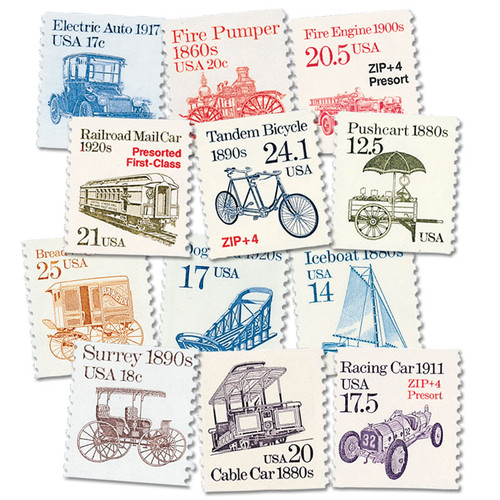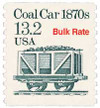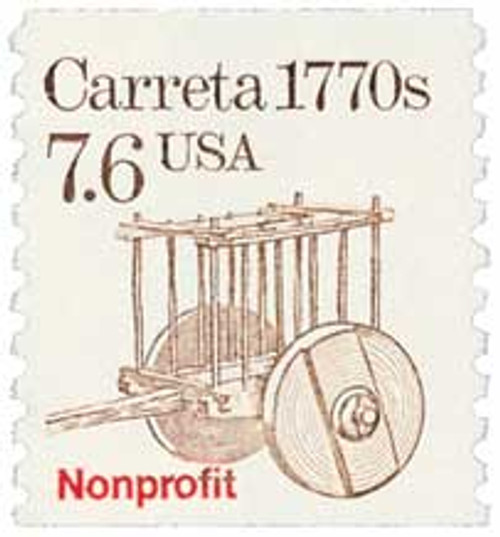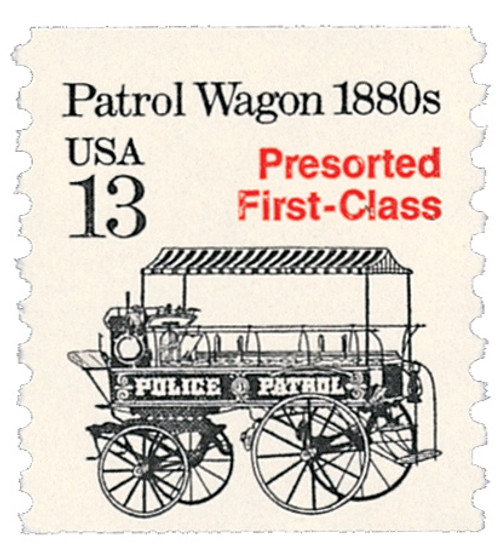
# 2259 - 1988 13.2c Transportation Series: Coal Car, 1870s
U.S. #2259
1988 13.2¢ Coal Car, 1870s
Transportation Series
- Stamp image based on photo of 1873 coal car
- Paid the bulk rate for items presorted to five-digit ZIP codes
Stamp Category: Definitive
Series: Transportation
Value: 13.2¢, rate for single items presorted to five-digit ZIP codes
First Day of Issue: July 19, 1988
First Day City: Pittsburgh, Pennsylvania
Quantity Issued: 425,011,000
Printed by: Bureau of Engraving and Printing
Printing Method: Engraved
Format: Coils of 500 and 3,000
Perforations: 10 vertical
Color: Slate green
Why the stamp was issued: This stamp replaced the 1985 10¢ Oil Wagon stamp, paying the rate for single items presorted to five-digit ZIP codes. This subject was among those favored by a poll of Linn’s Stamp News readers in 1987.
About the stamp design: Richard Schlecht created the art for this stamp, based on a photo of an 1873 coal car owned by the Billmyer and Small firm of York, Pennsylvania.
Special design details: This stamp has a “Bulk Rate” precancel. Precancels are stamps canceled before being sold, to make mailing faster and cheaper for customers with large amounts of mail. Bulk mailers use precancels, then pre-sort their mail and save money.
First Day City: The First Day ceremony for this stamp was held at the Mellon Science Center at Duquesne University, in Pittsburgh, Pennsylvania.
Unusual fact about this stamp: A few hundred imperforate error pairs have been found.
About the Transportation Series: On May 18, 1981, the USPS issued the first stamp in the Transportation Series, US #1907, picturing the Surrey, a doorless four-wheeled carriage. For the first time in US history, a coil stamp featured its own unique design rather than simply copying that of the current definitive stamp. Over 50 more coil stamps would be issued over the course of the next 15 years, each picturing a different mode of transportation. All of these types of transportation were used since American independence.
The various denominations provided face values to exactly match the rates for several categories of Third-Class mail (bulk rate and quantity-discounted mail). As the rates changed, new stamps with new values were added. Never before had a stamp series included so many fractional cent values.
The Bureau of Engraving and Printing printed most of the stamps in the Transportation Series, although private contractors printed a few. All but a few of the later stamps were produced by engraved intaglio. Differences in precancels, tagging, paper and gum provide a large number of varieties.
Scott Catalog separates the Transportation stamps into four groups. The stamps in the first group (#1897-1908) generally have the denomination in small type with a “c” next to it. These stamps were printed on the Cottrell rotary press, which joined together two plates to make a sleeve. The gaps between these plates created depressions where ink would collect and create joint lines on the stamps. Later issues were printed on a different press and didn’t have these joint lines.
The second group (#2123-36) had larger numbers with no “c.” The third group (#2252-66) was similar in appearance to the second group, but service inscriptions were added to the designs. These stamps also used a variety of paper and gum as well as different types of tagging. The fourth group (#2451-68) marked the end of fractional values. Now bulk mailers would use either the 5¢ or 10¢ stamp and then pay the difference from the actual postage rate.
The last stamp in the Transportation Series, the 20¢ Cog Railway, was issued on June 9, 1995, at the TEXPEX ’95 stamp show in Dallas, Texas. This marked the end of the largest US definitive series up to that time and the largest US coil stamp series in history. Three new series would eventually replace it – American Transportation, American Culture, and American Scenes. Additionally, the Great Americans would go on to become the largest American definitive series.
History the stamp represents: Until the mid-19th century, coal was hauled to the surface by mules or by the miners themselves - making mining a slow and dangerous process. With the development of the locomotive, coal was soon being carried by a variation of the railroad car - the coal mining car. Today, continued improvements add to the safety and efficiency of mining.
West Virginia is the nation’s third-largest coal producing state. Only Wyoming and Kentucky produce more coal. Coal deposits lie under half of West Virginia’s territory. Minerals are the state’s chief natural resource, and coal is its most valuable mineral. Coal provides 85% of West Virginia’s mining income.
The coal industry began its rapid growth after the Civil War. Railroads and the industrial growth they fostered created a huge demand for the fuel. Between 1860 and 1920, large numbers of immigrants were hired as miners. The work was hard and dangerous – in 1907, a single mine explosion killed 361 miners. The United Mine Workers of America began to organize West Virginia miners in 1890. Before and after World War I, there were fierce conflicts between the miners and the mine owners. In 1933, under the terms of the National Recovery Administration, wages were increased, work hours were shortened, and overall conditions were improved.
Today, there is less demand for coal, which is a major source of air pollution. Also, new machine technology has enabled fewer people to mine larger amounts of coal. As a result, the mining industry employs far fewer people.
U.S. #2259
1988 13.2¢ Coal Car, 1870s
Transportation Series
- Stamp image based on photo of 1873 coal car
- Paid the bulk rate for items presorted to five-digit ZIP codes
Stamp Category: Definitive
Series: Transportation
Value: 13.2¢, rate for single items presorted to five-digit ZIP codes
First Day of Issue: July 19, 1988
First Day City: Pittsburgh, Pennsylvania
Quantity Issued: 425,011,000
Printed by: Bureau of Engraving and Printing
Printing Method: Engraved
Format: Coils of 500 and 3,000
Perforations: 10 vertical
Color: Slate green
Why the stamp was issued: This stamp replaced the 1985 10¢ Oil Wagon stamp, paying the rate for single items presorted to five-digit ZIP codes. This subject was among those favored by a poll of Linn’s Stamp News readers in 1987.
About the stamp design: Richard Schlecht created the art for this stamp, based on a photo of an 1873 coal car owned by the Billmyer and Small firm of York, Pennsylvania.
Special design details: This stamp has a “Bulk Rate” precancel. Precancels are stamps canceled before being sold, to make mailing faster and cheaper for customers with large amounts of mail. Bulk mailers use precancels, then pre-sort their mail and save money.
First Day City: The First Day ceremony for this stamp was held at the Mellon Science Center at Duquesne University, in Pittsburgh, Pennsylvania.
Unusual fact about this stamp: A few hundred imperforate error pairs have been found.
About the Transportation Series: On May 18, 1981, the USPS issued the first stamp in the Transportation Series, US #1907, picturing the Surrey, a doorless four-wheeled carriage. For the first time in US history, a coil stamp featured its own unique design rather than simply copying that of the current definitive stamp. Over 50 more coil stamps would be issued over the course of the next 15 years, each picturing a different mode of transportation. All of these types of transportation were used since American independence.
The various denominations provided face values to exactly match the rates for several categories of Third-Class mail (bulk rate and quantity-discounted mail). As the rates changed, new stamps with new values were added. Never before had a stamp series included so many fractional cent values.
The Bureau of Engraving and Printing printed most of the stamps in the Transportation Series, although private contractors printed a few. All but a few of the later stamps were produced by engraved intaglio. Differences in precancels, tagging, paper and gum provide a large number of varieties.
Scott Catalog separates the Transportation stamps into four groups. The stamps in the first group (#1897-1908) generally have the denomination in small type with a “c” next to it. These stamps were printed on the Cottrell rotary press, which joined together two plates to make a sleeve. The gaps between these plates created depressions where ink would collect and create joint lines on the stamps. Later issues were printed on a different press and didn’t have these joint lines.
The second group (#2123-36) had larger numbers with no “c.” The third group (#2252-66) was similar in appearance to the second group, but service inscriptions were added to the designs. These stamps also used a variety of paper and gum as well as different types of tagging. The fourth group (#2451-68) marked the end of fractional values. Now bulk mailers would use either the 5¢ or 10¢ stamp and then pay the difference from the actual postage rate.
The last stamp in the Transportation Series, the 20¢ Cog Railway, was issued on June 9, 1995, at the TEXPEX ’95 stamp show in Dallas, Texas. This marked the end of the largest US definitive series up to that time and the largest US coil stamp series in history. Three new series would eventually replace it – American Transportation, American Culture, and American Scenes. Additionally, the Great Americans would go on to become the largest American definitive series.
History the stamp represents: Until the mid-19th century, coal was hauled to the surface by mules or by the miners themselves - making mining a slow and dangerous process. With the development of the locomotive, coal was soon being carried by a variation of the railroad car - the coal mining car. Today, continued improvements add to the safety and efficiency of mining.
West Virginia is the nation’s third-largest coal producing state. Only Wyoming and Kentucky produce more coal. Coal deposits lie under half of West Virginia’s territory. Minerals are the state’s chief natural resource, and coal is its most valuable mineral. Coal provides 85% of West Virginia’s mining income.
The coal industry began its rapid growth after the Civil War. Railroads and the industrial growth they fostered created a huge demand for the fuel. Between 1860 and 1920, large numbers of immigrants were hired as miners. The work was hard and dangerous – in 1907, a single mine explosion killed 361 miners. The United Mine Workers of America began to organize West Virginia miners in 1890. Before and after World War I, there were fierce conflicts between the miners and the mine owners. In 1933, under the terms of the National Recovery Administration, wages were increased, work hours were shortened, and overall conditions were improved.
Today, there is less demand for coal, which is a major source of air pollution. Also, new machine technology has enabled fewer people to mine larger amounts of coal. As a result, the mining industry employs far fewer people.






















